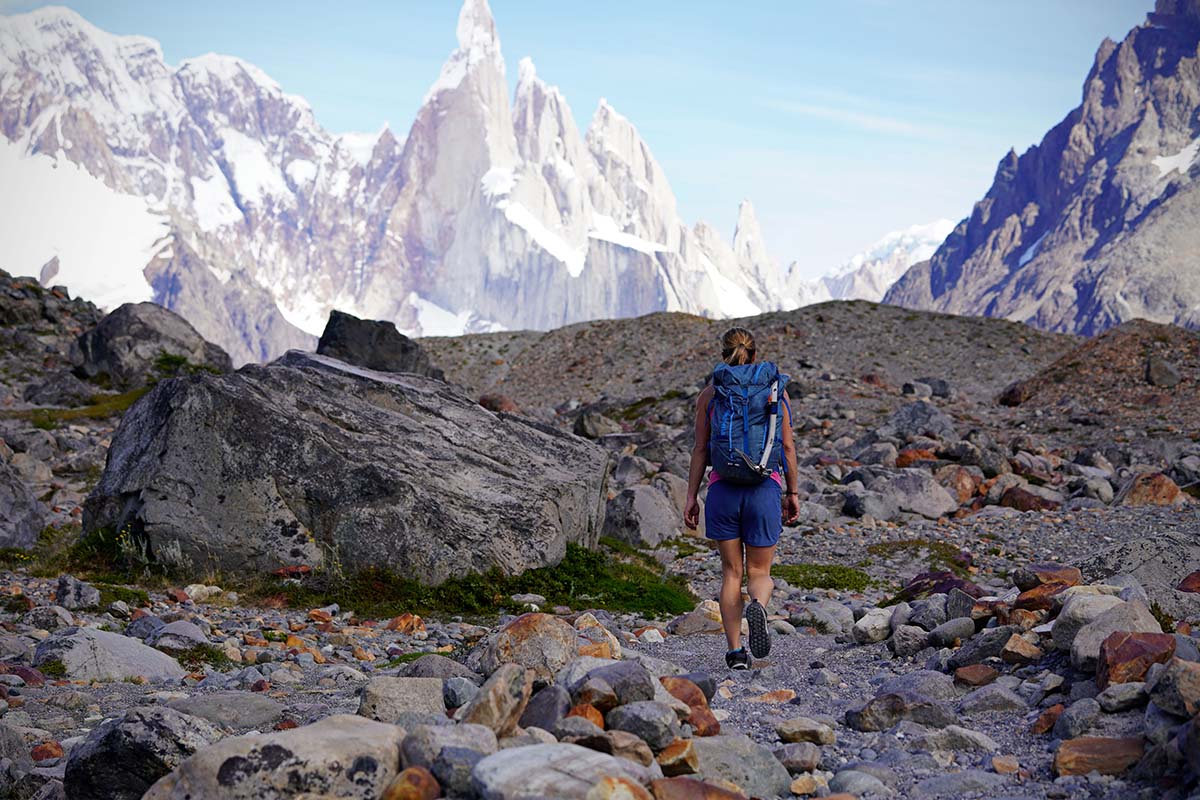
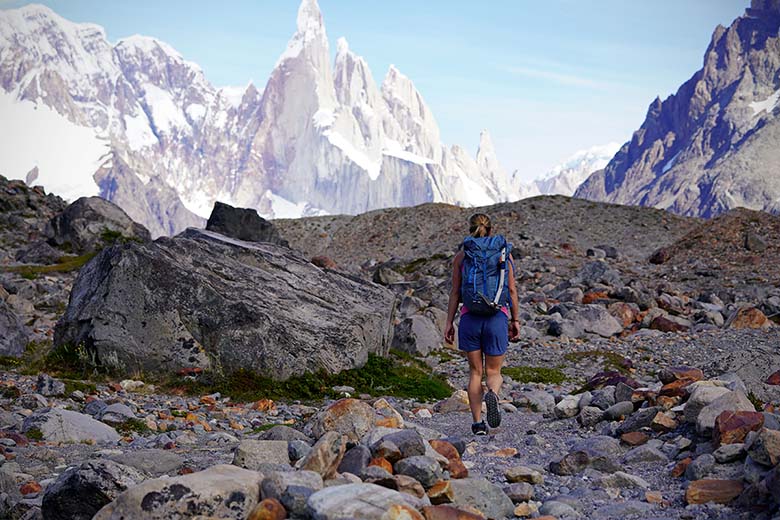
Switchback Travel


Switchback Travel
Price: $120
Weight: 1 lb. 6.6 oz.
Upper: Leather
Sole: Stealth C4
What we like: Climbs exceptionally well and is very durable.
What we don’t: Stiff sole detracts from sensitivity and comfort—this is not our favorite approach shoe for hiking.
See the Men’s Five Ten Guide Tennie See the Women’s Five Ten Guide Tennie
Five Ten’s Guide Tennie is widely considered to be the first approach shoe ever made, and over 30 years later, it’s still a crowd favorite. The combination of durable materials, lightweight design, and a high degree of stability on rock make it one of the top all-around approach shoes money can buy. I wore the Guide Tennie both on standard cragging days at Smith Rock and down in Patagonia on long approaches to windy spires, and was especially impressed by its climbing-shoe-like precision on technical rock (after an initial break-in period). Below I break down the Guide Tennie’s climbing performance, hiking comfort, durability, weight, fit and sizing, and more. To see how it stacks up to the competition, see our article on the best approach shoes.
Thanks to the beveled toe design, stiff midsole, and premium climbing rubber sole, the Five Ten Guide Tennie is one of my favorite approach shoes for climbing on technical rock. Many models contain a layer of foam between the sole and the upper, but the Guide Tennie merges the rubber rand and sole into a streamlined beveled toe. This allows the shoe to perch on small edges with nearly the precision of a climbing slipper, and the stiff midsole transfers the power of the entire foot to where the toe meets the rock.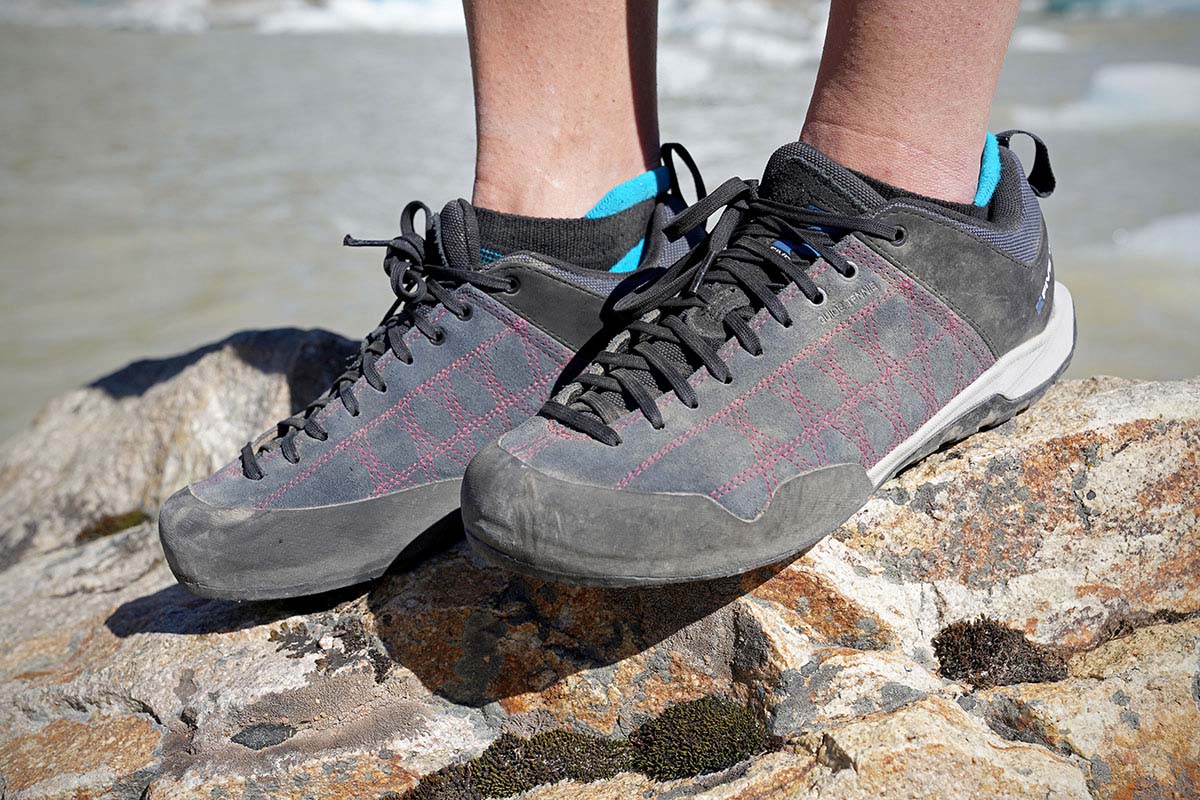
Additionally, Five Ten uses the same Stealth C4 rubber as their dedicated climbing shoes, making for a noticeably sticky sole. The shoe provided great traction while boulder-hopping along moraines in Patagonia, smearing up steep slab, and edging on low-5th-class terrain. Moreover, with this high-performance rubber covering a substantial part of the toe box, the Guide Tennie was sticky and durable in cracks too.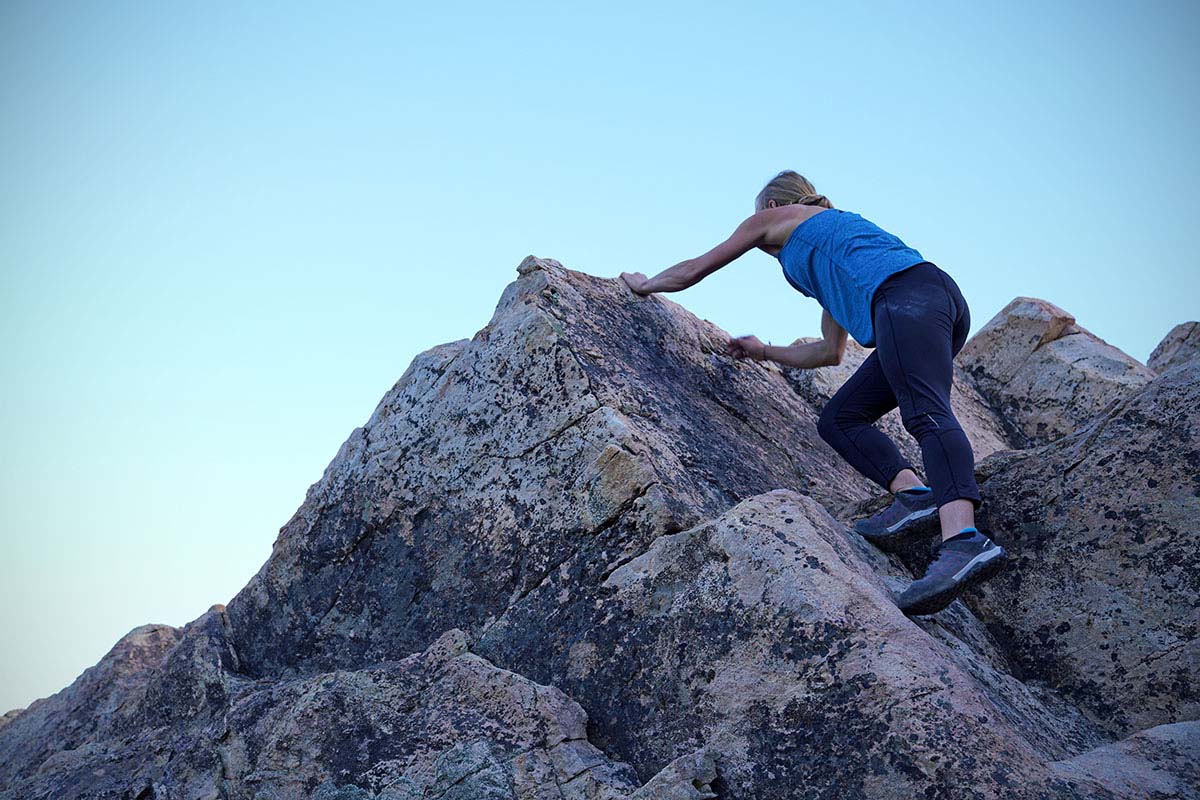
Out of the box, the sole of the Guide Tennie is overly thick and stiff, making for less sensitivity underfoot than I’d like. Though Stealth rubber provides class-leading traction on rock, it took me a few weeks to get over the feeling that I had bricks on my feet. It's worth mentioning that the Guide Tennie was last updated in late 2017, and the retooled model feels even stiffer than its predecessor, with extra cushioning around the ankle giving it a bulkier, clunkier feel. That said, after the break-in period, the Guide Tennie is both comfortable and responsive underfoot, retaining its climbing ability much more than a shoe without a beveled toe like the La Sportiva Boulder X or a mesh shoe like the La Sportiva TX3.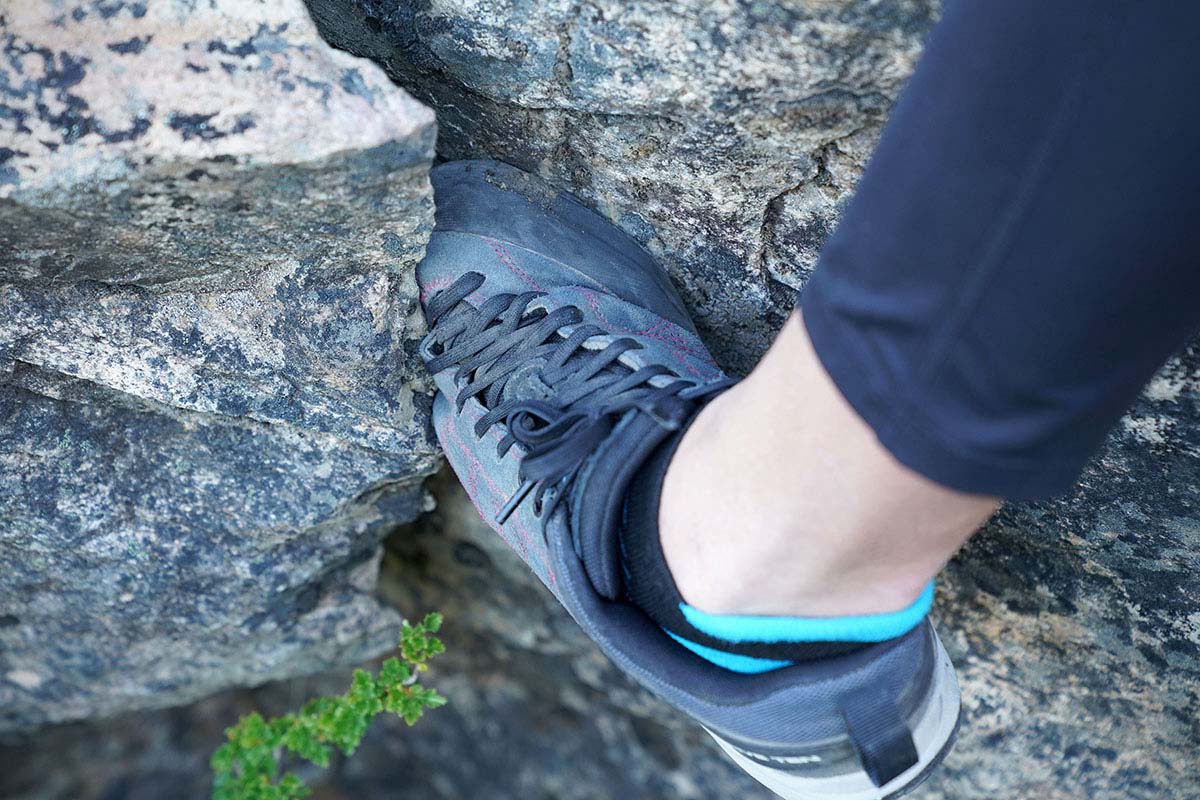
Simply put, the Guide Tennie isn’t my favorite shoe for hiking. We'll start with the good: it's relatively lightweight, sports padding around the ankle for comfort, and has a synthetic tongue and collar for more breathability. But even with these features, there’s no denying that the Guide Tennie is rigid and uncomfortable out of the box. The same stiffness that provides such a secure platform for climbing detracts from comfort and flexibility while hiking. Therefore, I highly recommend breaking the Guide Tennie in before a long approach—these shoes are notorious for giving blisters to new users.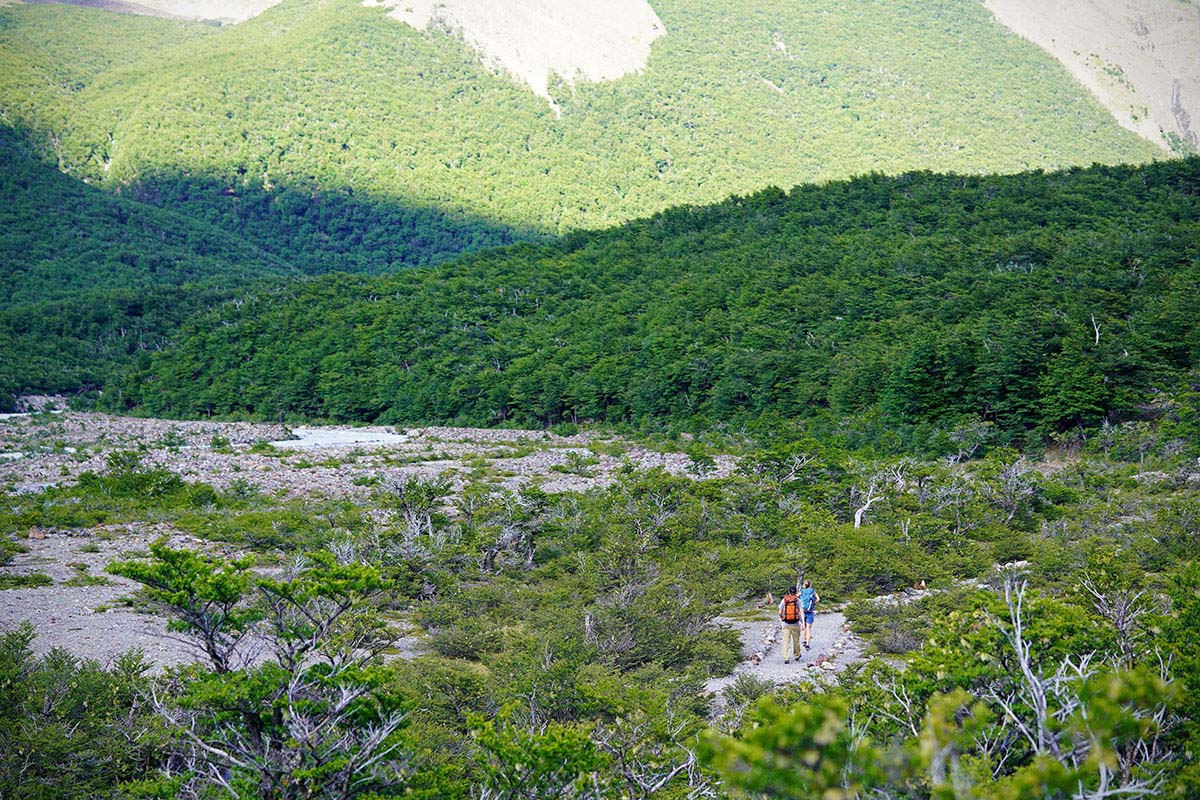
As mentioned above, the sole of the Guide Tennie is covered with Five Ten’s proprietary Stealth C4 rubber. After break-in, I enjoyed a high level of security underfoot during 3rd- and 4th-class scrambles and approaches over boulder fields. However, the “dotty” pattern of the rubber does not excel on wet terrain like slippery leaves, ice, or switching from snow to rock. For East Coast climbers or those frequenting mountain environments, I recommend opting for a shoe with sharper tread. The leather La Sportiva TX4 beats out the Guide Tennie when it comes to this sort of terrain, with dotted rubber on the tread of the forefoot and a rugged heel-braking platform in the rear (for more on the TX4, see our in-depth review).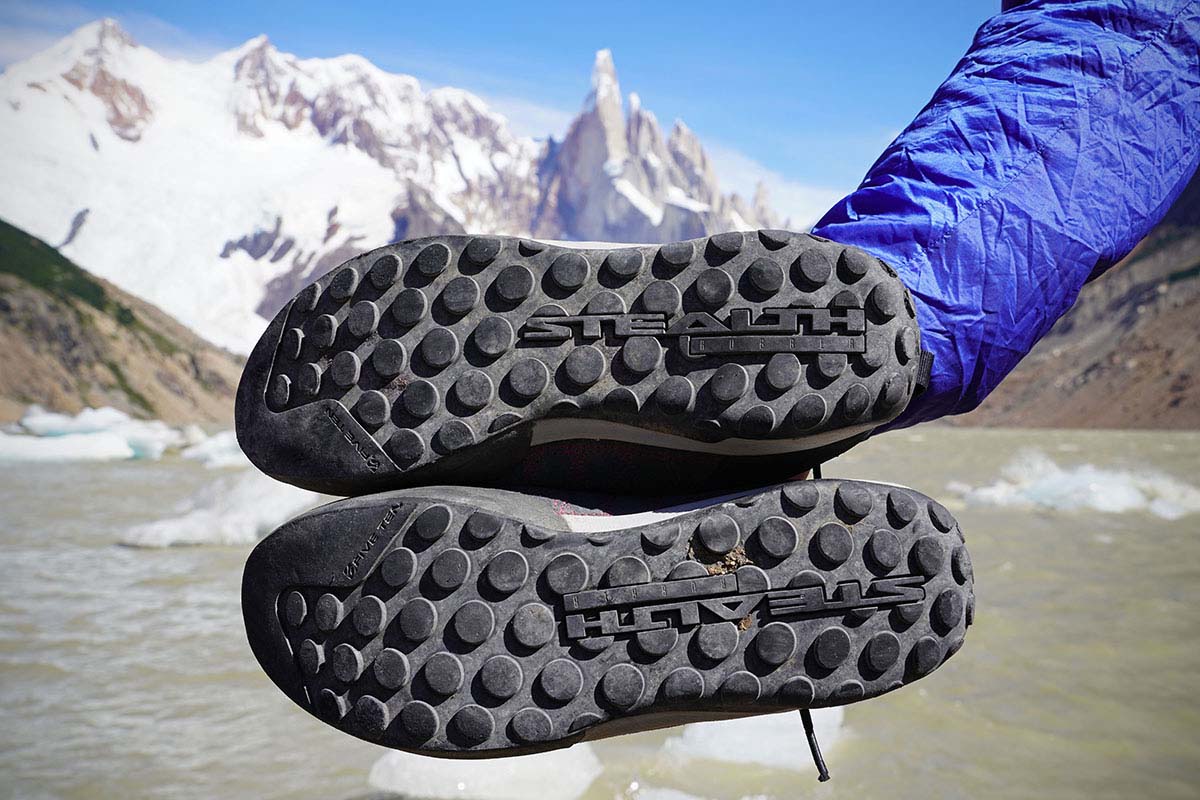
With a thick suede upper and burly sole, the Guide Tennie is one of the most durable approach shoes I've worn. Not only can the suede take a beating, but a rubber rand extends around the entire toe box, protecting this high-impact area from abrasion. I’ve worn the La Sportiva Boulder X (also leather) as well, and noticed that the Guide Tennie holds its shape better and stretches much less when wet. Moreover, it resists abrasions markedly better than a mesh shoe like La Sportiva’s TX3 or a canvas shoe like the Evolv Cruzer Psyche.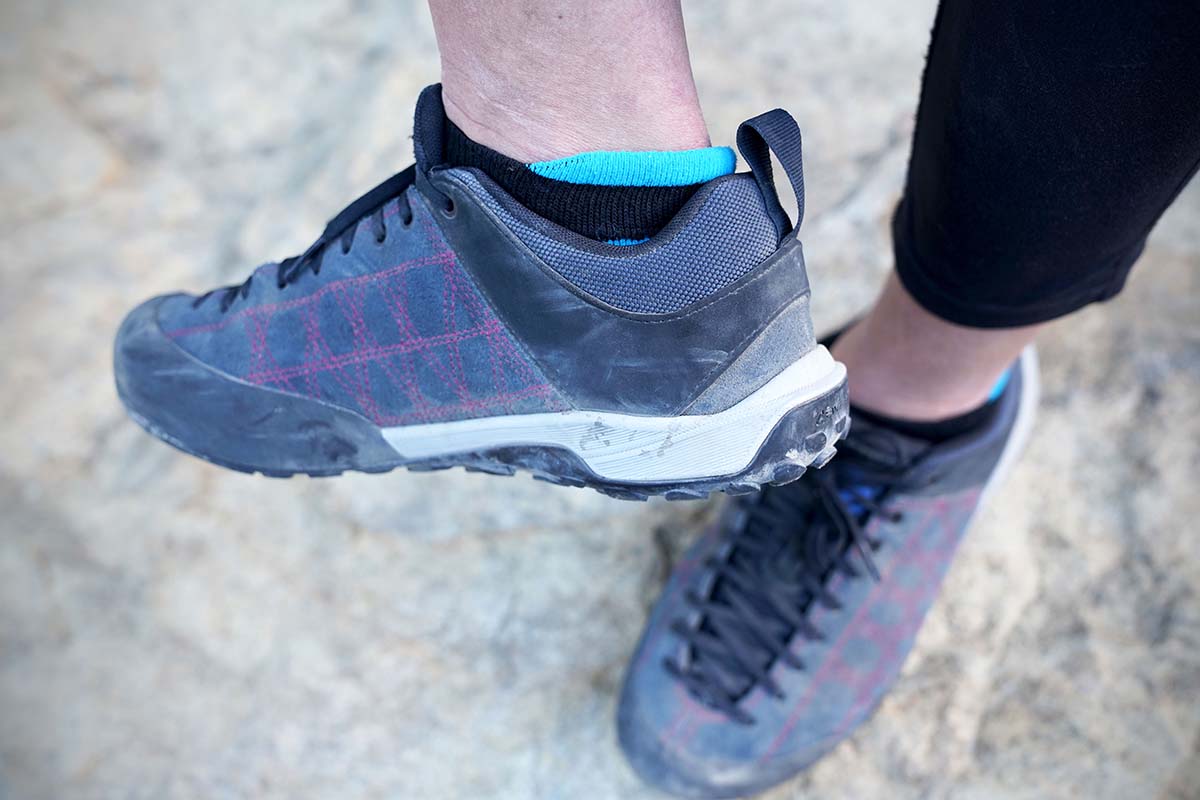
The Five Ten Guide Tennie has a substantial, mostly suede upper that provides high levels of water resistance. It isn’t fully waterproof like a Gore-Tex design, but I have worn these shoes through miles of wet snow and maintained dry feet. That said, I’d wager a bet that at some point the resistant properties of the suede will be compromised—whether through excessively wet conditions or general wear and tear—and the upper will become heavy when laden with water. To enhance or maintain the waterproofing, you can apply Nikwax products or Sno-Seal (although take care as this will affect breathability).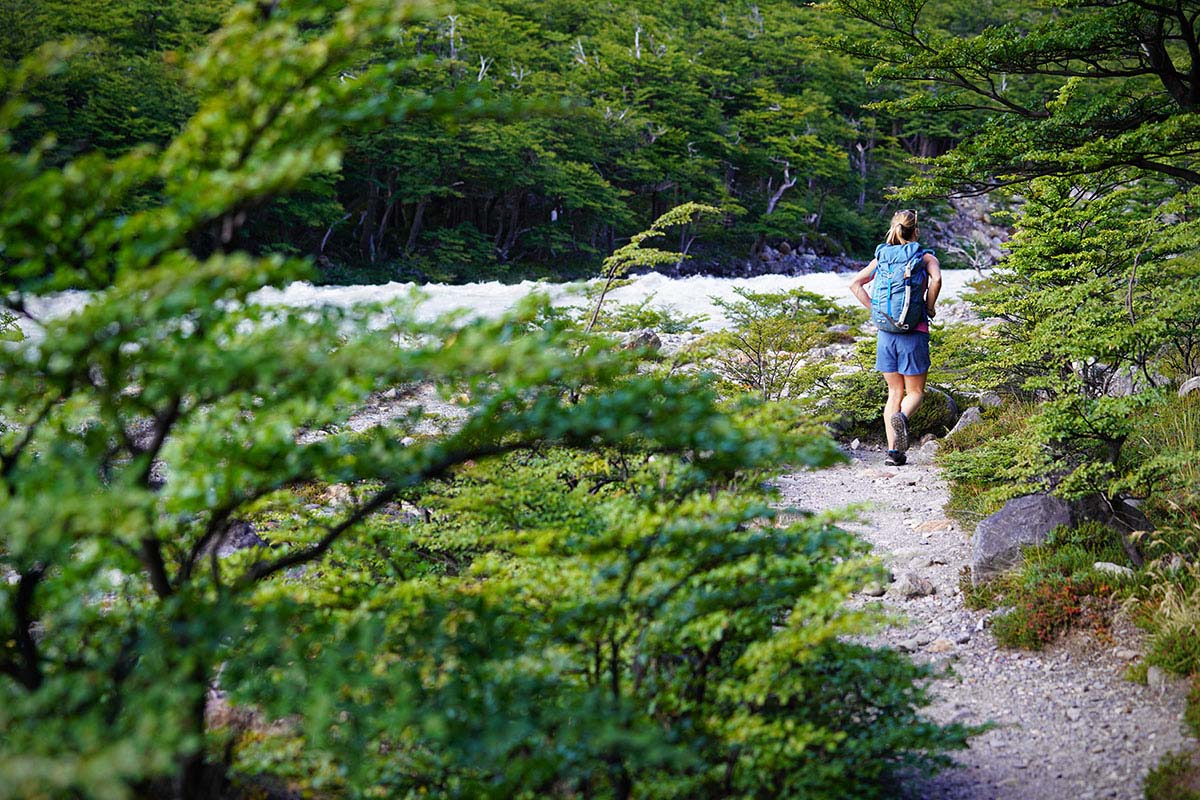
At 1 pound 6.6 ounces per pair for the women’s model, the Guide Tennie falls about mid-pack in terms of weight. For a mostly-suede shoe with a burly sole, that’s no small feat. My take is that for their weight, the Guide Tennies offer a superb combination of climbing performance and durability. For comparison, they are more than 2 ounces heavier than the all-around La Sportiva TX3 and a notable 6 ounces lighter than the popular La Sportiva Boulder X. The Guide Tennies are not my first choice for toting up a climb on my harness (check out a shoe like the La Sportiva TX2 for that), but in a pinch, they’ll definitely do the job without weighing you down too much.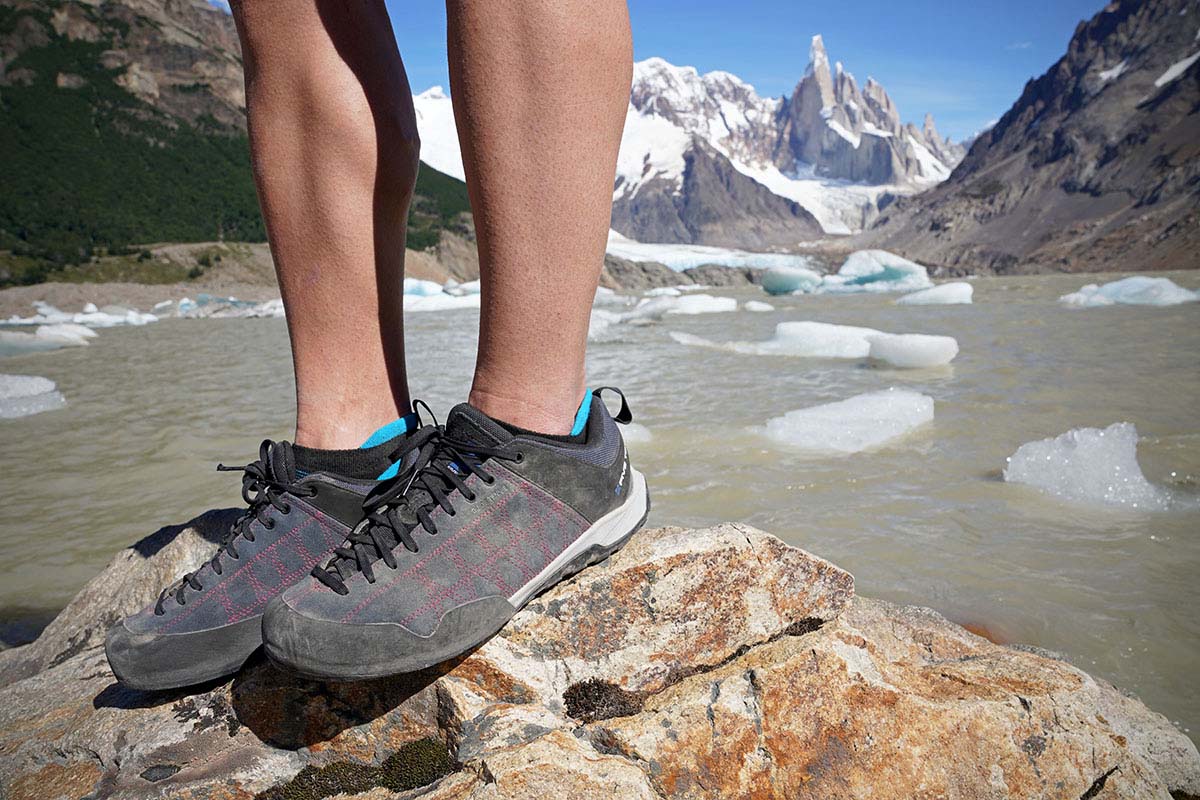
Five Ten sizes are all over the place, and I found that the Guide Tennie fits larger than stated. I recommend sizing down a half size, especially if you are purchasing the shoe to wear while climbing technical rock. Additionally, the leather stretches slightly, making the toe box roomier with wear. And these shoes accommodated my wide feet very well. A final note on fit: the flat laces on the Guide Tennies have proven to be secure and hold very well all day.
For this review, we tested the women’s Five Ten Guide Tennie. The shoe is also made in a men's version, which weighs slightly more (1 pound 10.4 ounces for a pair) and comes in different colorways, but with the same design overall. We haven’t worn the men’s version yet, but it’s safe to assume that it's designed to accommodate a slightly higher volume foot than the women's model and will offer similar climbing performance and durability.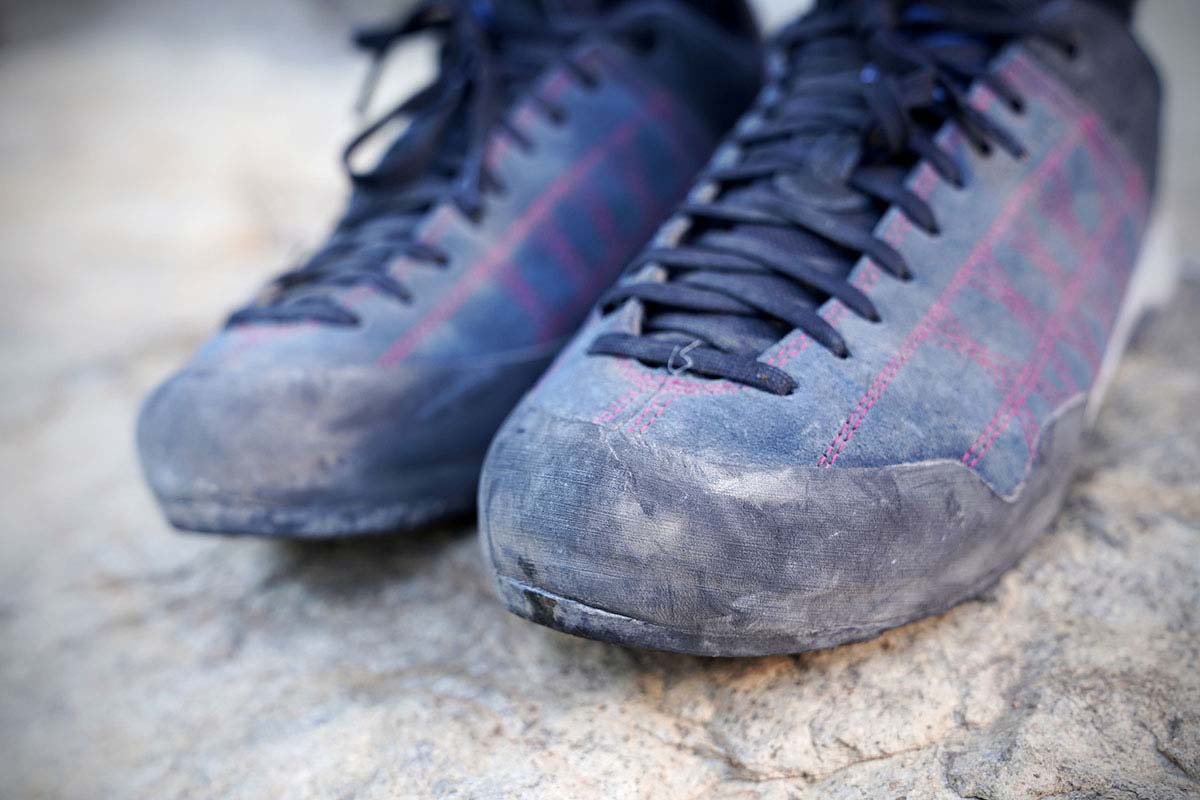
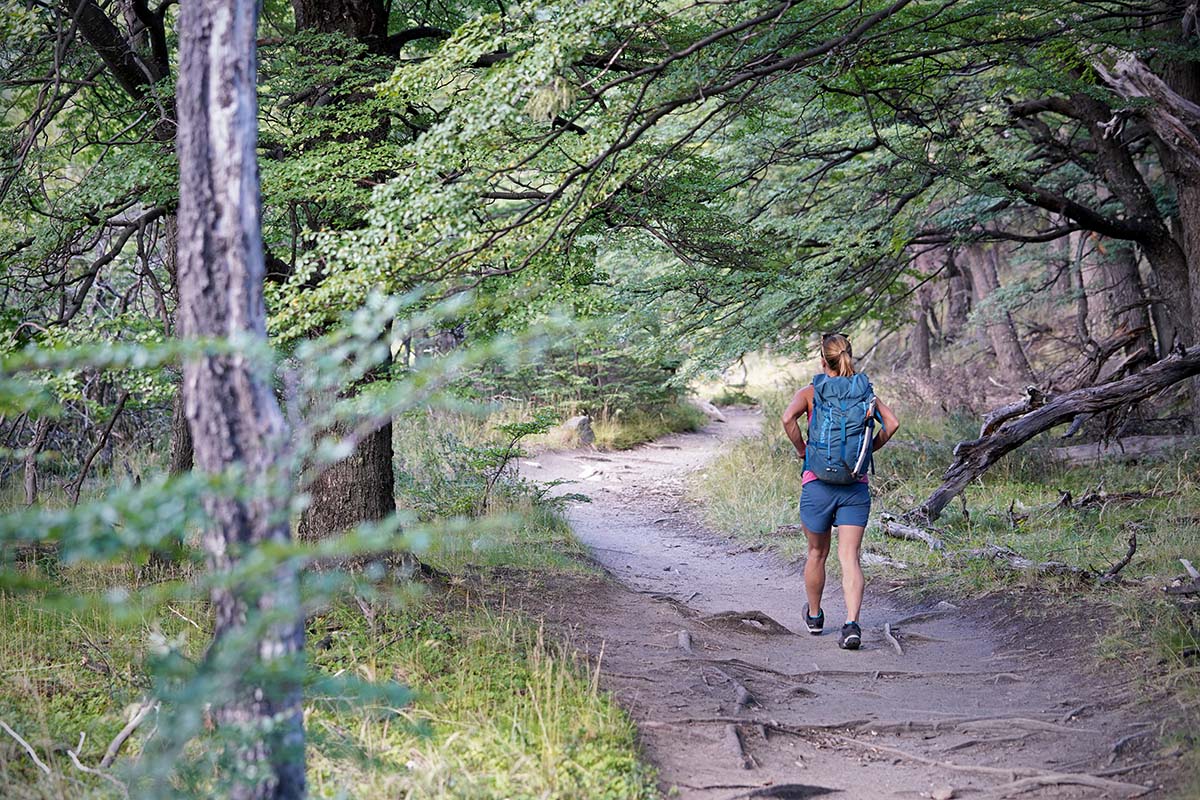
| Shoe | Price | Weight | Upper | Sole | Waterproof |
|---|---|---|---|---|---|
| Five Ten Guide Tennie | $120 | 1 lb. 6.6 oz. | Suede | Stealth C4 | No |
| La Sportiva TX4 | $140 | 1 lb. 4.8 oz. | Leather | Vibram Megagrip Traverse | No |
| Scarpa Crux | $130 | 1 lb. 6.8 oz. | Suede | Vibram Megagrip | No |
| Black Diamond Technician | $135 | 1 lb. 2.6 oz. | Synthetic knit | BlackLabel-Mountain | No |
| Scarpa Gecko | $169 | 1 lb. 6.6 oz. | Suede | Vibram Reptilia HG/IdroGrip | No |
The Five Ten Guide Tennie ($120) is one of many approach shoes that feature a leather build for increased durability, protection, and comfort. La Sportiva’s TX line is only a few years old and doesn’t have quite the legacy of the Guide Tennie, but the TX4 wins out as our favorite leather approach shoe of 2020. With a wider toe box and slightly lighter and more supple build, the La Sportiva TX4 is noticeably more comfortable and supportive. You also won't suffer the same break-in period as you do with the Five Ten—right away, the La Sportiva is responsive and flexible underfoot. Moreover, the heel brake provides better traction on mud, wet leaves, snow, and ice. Take note that the TX4 will cost you $20 more and you’ll sacrifice some climbing performance with the wider toe platform and looser fit, but we think it's worth it for the best-in-class mix of rock and on-trail performance. And for hot and dry missions, the mesh La Sportiva TX3 ($135) offers much more ventilation at the cost of durability and protection.
Scarpa’s Crux is another contender, especially for those who value hiking performance over prowess on technical rock. For $10 more than the Guide Tennie, you get a leather shoe with a suppler, roomier build for comfort mile after mile. Further, the sole of the Crux features a sharper, more varied tread throughout, giving it better traction on wet leaves, ice, snow, and mud. That said, you do give up the climbing capabilities of the Guide Tennie, which is particularly noticeable with the more flexible outsole and layers of soft cushioning along the edging platform that interfere with precision on small holds. We like the Crux for long, straightforward approaches but wouldn’t recommend it those who prefer to climb 5.8 in their approach shoes.
Early in 2020, Black Diamond released their flagship lineup of approach shoes, which includes two lifestyle models and two technical offerings. We’ve worn the Mission LT (see our in-depth review here) and have been impressed with its durability and comfort on the trail. The Technician ($135), on the other hand, is Black Diamond’s more climbing-focused approach shoe and a good alternative to the Guide Tennie. With a flat sole, dotted rubber on the forefoot, and a streamlined toe box for a precise fit, you get many of the same features as the Five Ten, but with one main difference: the Black Diamond Technician is built with a durable knit upper rather than leather. In the end, you’ll have to decide if the breathability and softness of the Technician are worth the inevitable (albeit slight) tradeoff in terms of precision, water resistance, and durability.
Last but not least, the Gecko is Scarpa’s premium approach shoe offering, with similar durability, climbability, and protection to the Guide Tennie. In terms of climbing performance, the inside toe box of the leather Gecko has the same streamlined, climbing-shoe-like build that we see on the Five Ten, offering a solid—albeit slightly less stiff—platform on dime edges. Further, we find the Gecko’s fit to be even better for slab and crack climbing, with less cushioning around the ankle and a heel cup that holds the foot in place for superb precision. Both shoes give up a little trail comfort with their snug fit, stiff builds, and minimal cushion, but the Gecko’s sharper Vibram tread means you get better traction on wet leaves, snow, and other slippery terrain. In the end, if you’re willing to stomach the $169 price tag, it's hard to match the Gecko's quality and on-trail performance.